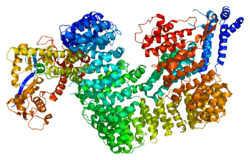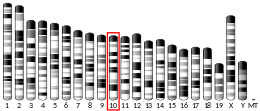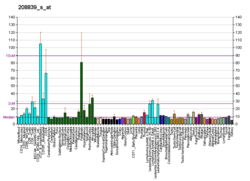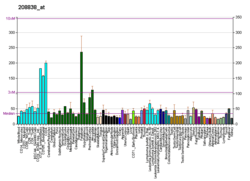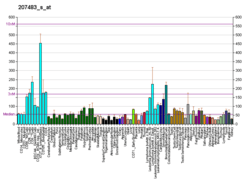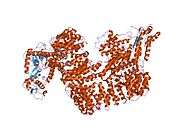CAND1
Cullin-associated NEDD8-dissociated protein 1 is a protein that in humans is encoded by the CAND1 gene.[5][6][7]
Interactions
CAND1 has been shown to interact with:
gollark: It's the future relative to the past, in any case.
gollark: This is the FUTURE. The Unicode Consortium has given us EMOJIS. We must USE THEM!
gollark: Idea: replace pronouns with emojis.
gollark: It's "correct" in that it, well, works as a valid pronoun.
gollark: Meh.
References
- GRCh38: Ensembl release 89: ENSG00000111530 - Ensembl, May 2017
- GRCm38: Ensembl release 89: ENSMUSG00000020114 - Ensembl, May 2017
- "Human PubMed Reference:". National Center for Biotechnology Information, U.S. National Library of Medicine.
- "Mouse PubMed Reference:". National Center for Biotechnology Information, U.S. National Library of Medicine.
- Nagase T, Ishikawa K, Suyama M, Kikuno R, Hirosawa M, Miyajima N, Tanaka A, Kotani H, Nomura N, Ohara O (Dec 1998). "Prediction of the coding sequences of unidentified human genes. XII. The complete sequences of 100 new cDNA clones from brain which code for large proteins in vitro". DNA Research. 5 (6): 355–64. doi:10.1093/dnares/5.6.355. PMID 10048485.
- Yogosawa S, Makino Y, Yoshida T, Kishimoto T, Muramatsu M, Tamura T (Dec 1996). "Molecular cloning of a novel 120-kDa TBP-interacting protein". Biochemical and Biophysical Research Communications. 229 (2): 612–7. doi:10.1006/bbrc.1996.1852. PMID 8954946.
- "Entrez Gene: CAND1 cullin-associated and neddylation-dissociated 1".
- Min KW, Hwang JW, Lee JS, Park Y, Tamura TA, Yoon JB (May 2003). "TIP120A associates with cullins and modulates ubiquitin ligase activity". The Journal of Biological Chemistry. 278 (18): 15905–10. doi:10.1074/jbc.M213070200. PMID 12609982.
- Menon S, Tsuge T, Dohmae N, Takio K, Wei N (2008). "Association of SAP130/SF3b-3 with Cullin-RING ubiquitin ligase complexes and its regulation by the COP9 signalosome". BMC Biochemistry. 9: 1. doi:10.1186/1471-2091-9-1. PMC 2265268. PMID 18173839.
- Kim AY, Bommeljé CC, Lee BE, Yonekawa Y, Choi L, Morris LG, Huang G, Kaufman A, Ryan RJ, Hao B, Ramanathan Y, Singh B (Nov 2008). "SCCRO (DCUN1D1) is an essential component of the E3 complex for neddylation". The Journal of Biological Chemistry. 283 (48): 33211–20. doi:10.1074/jbc.M804440200. PMC 2586271. PMID 18826954.
External links
- Human CAND1 genome location and CAND1 gene details page in the UCSC Genome Browser.
Further reading
- Yogosawa S, Kayukawa K, Kawata T, Makino Y, Inoue S, Okuda A, Muramatsu M, Tamura T (Dec 1999). "Induced expression, localization, and chromosome mapping of a gene for the TBP-interacting protein 120A". Biochemical and Biophysical Research Communications. 266 (1): 123–8. doi:10.1006/bbrc.1999.1773. PMID 10581176.
- Hu RM, Han ZG, Song HD, Peng YD, Huang QH, Ren SX, Gu YJ, Huang CH, Li YB, Jiang CL, Fu G, Zhang QH, Gu BW, Dai M, Mao YF, Gao GF, Rong R, Ye M, Zhou J, Xu SH, Gu J, Shi JX, Jin WR, Zhang CK, Wu TM, Huang GY, Chen Z, Chen MD, Chen JL (Aug 2000). "Gene expression profiling in the human hypothalamus-pituitary-adrenal axis and full-length cDNA cloning". Proceedings of the National Academy of Sciences of the United States of America. 97 (17): 9543–8. doi:10.1073/pnas.160270997. PMC 16901. PMID 10931946.
- Wiemann S, Weil B, Wellenreuther R, Gassenhuber J, Glassl S, Ansorge W, Böcher M, Blöcker H, Bauersachs S, Blum H, Lauber J, Düsterhöft A, Beyer A, Köhrer K, Strack N, Mewes HW, Ottenwälder B, Obermaier B, Tampe J, Heubner D, Wambutt R, Korn B, Klein M, Poustka A (Mar 2001). "Toward a catalog of human genes and proteins: sequencing and analysis of 500 novel complete protein coding human cDNAs". Genome Research. 11 (3): 422–35. doi:10.1101/gr.GR1547R. PMC 311072. PMID 11230166.
- Liu J, Furukawa M, Matsumoto T, Xiong Y (Dec 2002). "NEDD8 modification of CUL1 dissociates p120(CAND1), an inhibitor of CUL1-SKP1 binding and SCF ligases". Molecular Cell. 10 (6): 1511–8. doi:10.1016/S1097-2765(02)00783-9. PMID 12504025.
- Zheng J, Yang X, Harrell JM, Ryzhikov S, Shim EH, Lykke-Andersen K, Wei N, Sun H, Kobayashi R, Zhang H (Dec 2002). "CAND1 binds to unneddylated CUL1 and regulates the formation of SCF ubiquitin E3 ligase complex". Molecular Cell. 10 (6): 1519–26. doi:10.1016/S1097-2765(02)00784-0. PMID 12504026.
- Min KW, Hwang JW, Lee JS, Park Y, Tamura TA, Yoon JB (May 2003). "TIP120A associates with cullins and modulates ubiquitin ligase activity". The Journal of Biological Chemistry. 278 (18): 15905–10. doi:10.1074/jbc.M213070200. PMID 12609982.
- Feng S, Shen Y, Sullivan JA, Rubio V, Xiong Y, Sun TP, Deng XW (Jul 2004). "Arabidopsis CAND1, an unmodified CUL1-interacting protein, is involved in multiple developmental pathways controlled by ubiquitin/proteasome-mediated protein Degradation". The Plant Cell. 16 (7): 1870–82. doi:10.1105/tpc.021949. PMC 514167. PMID 15208391.
- Goldenberg SJ, Cascio TC, Shumway SD, Garbutt KC, Liu J, Xiong Y, Zheng N (Nov 2004). "Structure of the Cand1-Cul1-Roc1 complex reveals regulatory mechanisms for the assembly of the multisubunit cullin-dependent ubiquitin ligases". Cell. 119 (4): 517–28. doi:10.1016/j.cell.2004.10.019. PMID 15537541.
- Min KW, Kwon MJ, Park HS, Park Y, Yoon SK, Yoon JB (Sep 2005). "CAND1 enhances deneddylation of CUL1 by COP9 signalosome". Biochemical and Biophysical Research Communications. 334 (3): 867–74. doi:10.1016/j.bbrc.2005.06.188. PMID 16036220.
- Otsuki T, Ota T, Nishikawa T, Hayashi K, Suzuki Y, Yamamoto J, Wakamatsu A, Kimura K, Sakamoto K, Hatano N, Kawai Y, Ishii S, Saito K, Kojima S, Sugiyama T, Ono T, Okano K, Yoshikawa Y, Aotsuka S, Sasaki N, Hattori A, Okumura K, Nagai K, Sugano S, Isogai T (2007). "Signal sequence and keyword trap in silico for selection of full-length human cDNAs encoding secretion or membrane proteins from oligo-capped cDNA libraries". DNA Research. 12 (2): 117–26. doi:10.1093/dnares/12.2.117. PMID 16303743.
This article is issued from Wikipedia. The text is licensed under Creative Commons - Attribution - Sharealike. Additional terms may apply for the media files.
